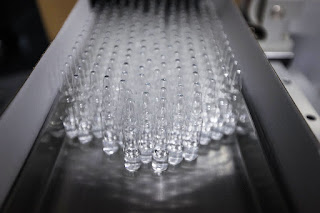The coronavirus vaccines have become a precious commodity. Not for their value, but for the perception they make a difference between life and death, between economic recovery and chronic recession.
Brexit has happened, and the sovereign UK has managed
to vaccinate 40% of Britons, while only 10% of EU citizens have received the
first shot. The Oxford/AstraZeneca is manufactured in Belgium and shipped to
the UK. How can you ethically justify vaccinating a 30-year-old Briton, while
keeping a 70-year-old Belgian waiting, asks the EU’s trade commissioner.
*****
Last weekend, the Italian paper La Stampa reported a
police raid on the Catalent factory in Angani near Rome. The EU commission
suspected the plant was hiding vaccine stocks for shipment to the UK. Tipped by
them, the Italian police raided the place and found 29 million AstraZeneca
doses “hidden”. After four days of investigation, it was confirmed yesterday
the facility was a legitimate one for quality control. The doses were made outside
the EU and brought here to be filled into vials. After the quality control, 13
million will be dispatched to Covax, for distribution to poor nations. The
other 16 million were earmarked for Europe.
The European commission, satisfied, will still likely
announce a ban on export of vaccines from the EU, particularly to the UK.
*****
In an incident on another continent, on Monday, 22
March, at 09.00 a.m. three unmarked white vans left an armory in Lubbock, Texas.
Eleven uniformed soldiers from the Texas National Guard were given the
responsibility of transporting coronavirus vaccine stocks in those vans. Some
of the soldiers were so young, they could be mistaken for fresh trainees. After
driving for ten miles, the vans stopped at a gas station across the highway for
drinks. The guards were aware of the precious packages they were carrying.
After leaving the gas station, one of the three
drivers noticed a truck trying to bully the vans off the road. This road rage
went on for a few minutes. Finally, the truck swerved into oncoming traffic and
blocked the convoy. A white bearded man in his late sixties, flashed a colt
1911 pistol .45 Caliber. He ordered the 11 soldiers to stand on the side of the
road, hands raised above their heads. The bearded man had an additional loaded
magazine on his person. On that small town highway road there were hardly any
witnesses to this bizarre event.
The man said he was a detective, and that he wished to
inspect the three vans. While he examined the first van, a young soldier
managed to call 911.
In a few minutes, the Idalou Police Chief Eric Williams
arrived with his team on the scene. He was made aware the vans contained the
precious coronavirus vaccines. From a distance, the police chief saw the eleven
captive soldiers and the bearded elderly gunman.
At the sight of the police, the man surprisingly put
his pistol back in his trouser pocket. Before he could blink, the police had
overpowered and handcuffed him.
The man’s name was Larry Harris, a 66-year-old from
Alabama. A third magazine and more ammunition were found in the truck. He said he
chased the vans on the suspicion that a woman and a child were being kidnapped.
He is arrested on the charges of assault with a deadly weapon, unlawful restraint
of eleven soldiers, impersonating a public servant, and interference with Texas
military forces. The police chief said Larry Harris appeared to be mentally
disturbed.
After the arrest, the three vans moved without any further
incident and delivered the vaccines to the town of Matador, seventy miles
further.
*****
In the Texas story, I found it interesting that the 66-year-old
truck driver, possibly mentally disturbed, was armed to the teeth, while the
eleven American soldiers had absolutely no weapons.
Ravi









